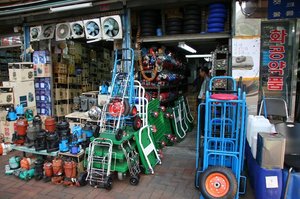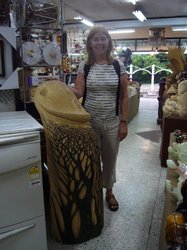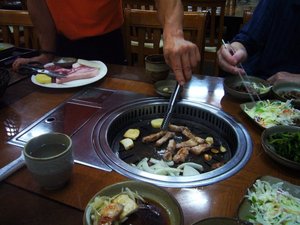Korean Ginseng
Korean ginseng is a deciduous perennial herb
that reaches a height of 60 to 80 cm, with
typical light colored fleshy root. . The
root is long and slender and sometimes resembles
the shape of the human body. The ginseng
stem is erect and deep red coloured. Korean
ginseng gives small red berries. Cultivated
in moist fields, it is covered by black screens
so that it does not get the direct sunlight.
The taste of the Korean ginseng root is sweetish
at first but with a bitter aftertaste.
Ginseng is cultivated and sold at an age
of 1 to 6 years with the premium ginseng
being 6 years. It can be purchased as a powder
or capsules or the raw root for cooking.
The roots of all ages can be seen in large
jars outside the shops.
Korean ginseng benefits include an increase
in energy and there is evidence that it gives
the immune system a boost. |
|
 South Korea is impressively progressive with excellent
infrastructure. The metro is really clean.
If you don’t have a weekly pass, you
purchase a ticket which is a plastic card
with a chip and then you get a refund by
inserting the card in a machine at the destination.
The metro trains are very clean with no advertising,
although there was a video advert outside
the window on an occasion whilst travelling.
Launched in 2004, the KTX train is based
on the French TGV high speed train. It runs
at 300km per hour and is always on time and
it even has free wireless internet on board.
On our trip from Seoul to Gyeongju most of
the flat countryside was covered in cloches.
All roads are 4 lane expressways or dual
carriageway, however, traffic is bad and
packed with cars. Even after a 40 minute
drive you are still in the suburbs. There
are many service stations. Road rules are
lax and it’s common to see people using
mobiles whilst driving, even on a motor scooter.
By law all signage is in Korean and (good)
English, with some Chinese now being seen
due to the rise in Chinese tourism. In Jeju
there are scenic pictures on the electricity
cabinets in the streets.
 85% of the country is green forested hills.
Most people live in high rise flats and they
sleep on the floor. Of the 50million population,
80% live in Seoul and its suburbs; 10M live
in central Seoul. Categories of shops can
be seen on each street and it is generally
one type of product per shop, eg a street
of engineering with shops of cogs or wheels
or motors or chains or bolts.
The young girls all look slim; very few
are overweight. They dress very trendily
with fashionable high heel shoes. Most wear
glasses and some were seem to have false
glasses with no lens. The population has
dark black hair although some girls dye it
brown. There are lots of young girls wandering
around in doubles, holding hands, even at
night. We also saw many gay couples. We went
to a Bennigans fast food restaurant and 98%
were female under 30 years. Apparently, the
men work late in the office. S. Koreans only
get one week’s holiday each year.
It is quite common to see very young children
taking photos with their mobile phones. Free
wireless, high speed internet is everywhere,
with gadgets and mobiles in abundance
En route to Mt Seoraksan we stopped for a
break at an expressway services. In the complex
was a shop of 'dick-stick’ art - very creative
art, it has to be said, but in a public family
place....? Many shops in the Mt Seoraksan
have similar penis art, openly displayed.
|
|
Shanghai
Shanghai airport. If you are n transit your
baggage cannot be checked through so you
have to collect it and go through customs
and go to the departures to check into your
onward flight. In between you queue at passport
control and collect a transit stamp in your
passport.
The metro is very cheap with an average journey
being 4RMB. The trains are long, clean and
air-conditioned with open carriages so you
could see from one end of the train to the
other (if it were empty!). Stations are announced
in Chinese and English. Mobile phones have
reception throughout the journey. Taxis are
also very cheap with a minimum 12RMB for
up to km, plus 2RMB for 3-10km and 3RMB for
each extra km.
Motor Bikes, Scooters and Bikes are electric
and silent. At night many drive with no lights
thus making them silent and un-noticeable!.
They generally ignore traffic lights. Most
days we saw an accident and those involved
are not allowed to move their vehicle until
the police arrive – so you can imagine
the traffic chaos.
Western food and retail chains are more evident
than on previous trips – M & S,
Tesco Express, Carrefour and B & Q.
Signs
The Chinese need to take a lesson from S.
Korea and employ a good English speaking
person to check their signage.
|
|
 Hotels
Vabien II, Seoul – very comfortable,
centrally located suites.
Seorak Hotel, Mt Seoraksan – ideally
situated but rather shabby
Commodore Hotel, Gyeongju
Seaeas Hotel, Jeju Island – Excellent
rooms with own garden. Korean style food
Grand Mercure Hongqiao Hotel, Shanghai. –
excellent service and rooms
Recommended restaurants:
Ahudamiro Italian restaurant, Seoul
Shangri La, Jeju – all you can eat
buffet fish and sides
Mawon, Jeju – Local black pig bbq’d
on the table (see right)
Balthazar Brasserie – in the Tian Zi
Fang area of the French Concession, very
reasonable cost
Franck in Ferguson Lane, arguably the best French restaurant in town,
expensive
Mr & Mrs Bund Restaurant –
fabulous view from the terrace over the Bund
and Huangpu River
Korean Food is generally spicy, even though
they kept telling us that that it is not.
Even when our tour guide ordered food ‘without’
spice, it had some in!
Food in South Korea and China is vastly different
to Western food so be prepared to see the
unexpected, especially in the markets!
|
|
|
|